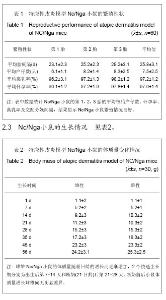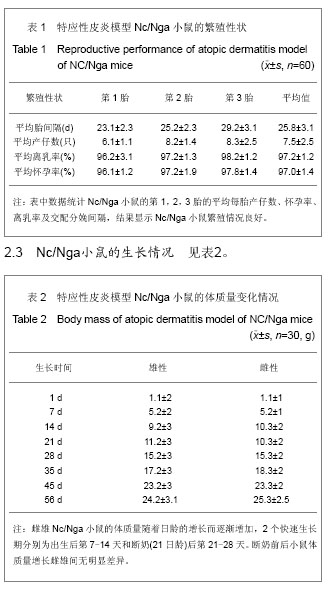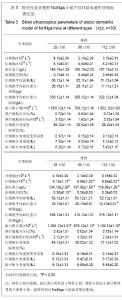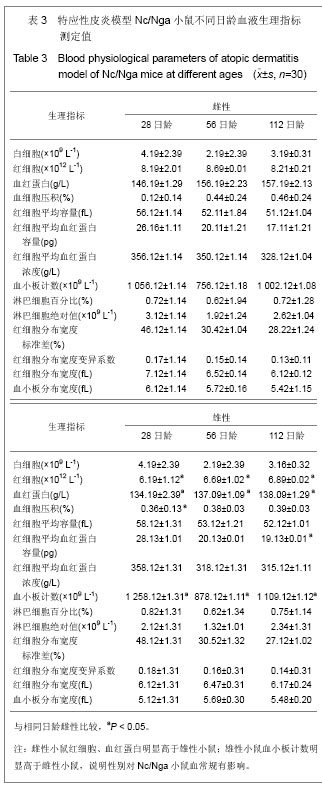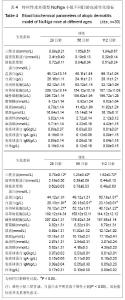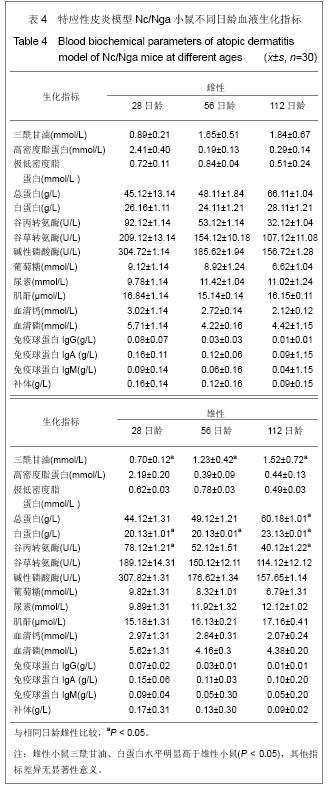Chinese Journal of Tissue Engineering Research ›› 2013, Vol. 17 ›› Issue (41): 7284-7289.doi: 10.3969/j.issn.2095-4344.2013.41.015
Previous Articles Next Articles
Growth, reproduction and blood physiological and biochemical indexes in an atopic dermatitis mouse model
Tong Min1, Liang Yun-sheng2, Zhang Gui-ying2
- 1Experimental Animal Center, 2Department of Dermatology and Venereology, the Second Xiangya Hospital of Central South University, Changsha 410000, Hunan
-
Received:2013-06-25Revised:2013-07-12Online:2013-10-08Published:2013-11-01 -
Contact:Zhang Gui-ying, Professor, Master’s supervisor, Department of Dermatology and Venereology, the Second Xiangya Hospital of Central South University, Changsha 410000, Hunan Province, China zhangguiying67@yahoo.com.cn -
About author:Tong Min★, Master, Associate chief technician, Experimental Animal Center, the Second Xiangya Hospital of Central South University, Changsha 410000, Hunan Province, China tongmin22626@163.com -
Supported by:Research Condition Innovation Project of Hunan Province, No. 2011TT2019*
CLC Number:
Cite this article
Tong Min, Liang Yun-sheng, Zhang Gui-ying. Growth, reproduction and blood physiological and biochemical indexes in an atopic dermatitis mouse model[J]. Chinese Journal of Tissue Engineering Research, 2013, 17(41): 7284-7289.
share this article
| [1] 云晴,杨高云,乌日娜,等.小鼠模型在特应性皮炎方面的研究进展[J].临床和医学实验杂志,2012,11(22):1827.
[2] 付萌, 赵小东, 廖文俊, 等. 特应性皮炎的治疗现状与进展[J]. 临床皮肤科杂志, 2006, 35(6): 410-412.
[3] Shiga T, Yokogawa M, Nakajima K, et al. Topical tacrolimus treatment does not facilitate photocarcinogenesis in cancer-prone mice. J Dermatol Sci. 2012;68(2): 112-115.
[4] Matsuoka A, Kato T, Soma Y, et al. Analysis of T cell receptor (TCR) BV-gene clonotypes in NC/Nga mice developing dermatitis resembling human atopic dermatitis. J Dermatol Sci. 2005;38(1):17-24.
[5] Jiang J, Yamaguchi T, Funakushi N, et al. Oral administration of Yokukansan inhibits the development of atopic dermatitis-like lesions in isolated NC/Nga mice. J Dermatol Sci. 2009;56(1):37-42.
[6] 尤立平,刘永生. 特应性皮炎动物模型Nc/Nga鼠的发现与研究进展[J].国外医学:皮肤性病学分册,2003,1(29):22.
[7] Yamashita H , Makinoa T, Mizukami H. Pharmacological characterization of a chronic pruritus model induced by multiple application of 2,4,6-trinitrochlorobenzene in NC mice. Eur J Pharmacol. 2007;563(1-3):233-239.
[8] Gao XK, Nakamura N, Fuseda K, et al. Establishment of allergic dermatitis in NC/Nga mice as a model for severe atopic dermatitis. J Biol Pharm Bull. 2004;27(9):1376-1381.
[9] Matsuoka H, Maki N, Yoshida S, et al.A mouse model of the atopic eczema/dermatitis syndrome by repeated application of a crude extract of house-dust mite Dermatophagoides farinae. J Allergy. 2003;58(2):139-45.
[10] 王俊风,施美莲,赵立虎,等.无菌级/OrISIac小鼠生长繁殖、主要脏器参数以及血液生理生化指标的测定分析[J].中国实验动物学报,2011,19(2):128.
[11] Kohara Y,Tanabe K,Matsuoka K, et al.A major determinant quantitative-trait.locus. responsible for atopir. dermatitis-like. skin lesions in NC/Nga mice is located on Chromosome 9.Immonogeneties. 2001;53(1):15-21.
[12] Fukuyama T, Kosaka T, Miyashita L, et al. Role of regulatory T cells in the induction of atopic dermatitis by immunosuppressive chemicals. Toxicol Lett. 2012;213(3): 392-401.
[13] Kim CH, Park CD, Lee AY. Administration of poly(I:C) improved dermatophagoides farinae-induced atopic dermatitis-like skin lesions in NC/Nga mice by the regulation of Th1/Th2 balance. Vaccine. 2012;30(14):2405-2410.
[14] Tanaka T,Tsutsui H,Yoshimoto T, et al. Interleukin-18 is elevated in the sera from patients with atopic dermatitis and from atopic dermatitis model mice NC/Nga. Int Arch Allergy Immunol. 2001;125(3):236-240.
[15] Habu Y,Seki S,Takayama E, et al. The mechanism of a defective IFN gamma response to bacterial toxins in an atopic dermatitis model. NC/Nga mice,and the therapeutic effect of IFN-gamma,IL-12,or IL-18 on dermatitis. J Immunol. 2001; 166 (9):5439-5447.
[16] Tobda C,Sugahara H,Kuraishi Y, et al.Inhibitory effect of Byakko-Ka-ninjin-to on itch in a mouse model of atopic dermatitis. Phytother Res. 2000;14(3):192-194.
[17] Fukuyama T, Tajima Y, Hayashi K, et al. Prior or coinstantaneous oral exposure to environmental immunosuppressive agents aggravates mite allergen-induced atopic dermatitis-like immunoreaction in NC/Nga mice. Toxicology. 2011;289(2):132-140.
[18] 郭亚南,文海泉.特应性皮炎小鼠模型研究新进展[J].皮肤性病诊疗学杂志,2010,17(3):247.
[19] 董正邦,张美华.特应性皮炎小鼠模型研究进展[J].国际皮肤性病学杂志,2006,1(32):32.
[20] 童敏,郭亚南,张桂英.吴茱萸次碱对特应性皮炎模型鼠治疗作用及机制探讨[J].四川大学学报:医学版,2011,2(42):234-236.
[21] 郭亚南,文海泉.DNCB致敏激发Nc/Nga小鼠特应性皮炎模型的建立[J].中国比较医学杂志,2010,20(5):12-14.
[22] 郭亚南,文海泉,张桂英,等. 卡介菌多糖核酸对二硝基氯苯诱导的Nc/Nga小鼠特应性皮炎样皮损的影响[J].中华皮肤科杂志, 2010, 43(7) 497-500.
[23] 王萍,张玉环. 特应性皮炎小鼠模型研究进展[J].中国临床医药研究杂志, 2005, 144: 15606-15608.
[24] 陈蕾, 樊翌明. 变应性接触性皮炎动物模型的研究进展[J]. 中国热带医学, 2008, 8(4): 683-685.
[25] 胡佳,张美华,毕志刚,等. 卵清蛋白经皮致敏诱发BALB/c小鼠特应性皮炎病变的探讨[J].临床皮肤科杂志,2006,35(6):373-375.
[26] 宋志强,郝飞. 特异性免疫治疗在特应性皮炎中的应用[J].中华临床免疫和变态反应杂志,2008,2(2):138-139.
[27] 涂彩霞,张新军,张蕴颖,等. 复方甘草酸酐治疗特应性皮炎的临床及实验研究[J].中国麻风皮肤病杂志,2007,5(23):393-394.
[28] Matsuoka A, Kato T, Soma Y, et al. Analysis of T cell receptor (TCR) BV-gene clonotypes in NC/Nga mice developing dermatitis resembling human atopic dermatitis.J Dermatol Sci. 2005;38(1): 17-24.
[29] Sakai T, Kogiso M, Mitsuya K, et al. Defect of toll-like receptor 9-mediated activation in NC/Nga mouse macrophages. Immunol Lett. 2006;106(1):91-95.
[30] Tominaga M, Ozawa S, Ogawa H, et al. A hypothetical mechanism of intraepidermal neurite formation in NC/Nga mice with atopic dermatitis. J Dermatol Sci. 2007;46(3): 199-210.
[31] Jiang J, Yamaguchi T, Funakushi N, et al. Oral administration of Yokukansan inhibits the development of atopic dermatitis-like lesions in isolated NC/Nga mice. J Dermatol Sci. 2009;56(1): 37-42.
[32] 张俭,黄星群,刘建军. BALB/c小鼠繁殖性能的观察及分析[J].四川动物,2006,25(1):179.
[33] 夏介英,雷培琪,曾晓兰,等.SPF级KM小鼠主要脏器重量和血液生化值的测定[J].四川生理科学杂志,2009,31(3):104-107.
[34] Fujiwara R, Takemura N, Watanabe J, et al. Maternal consumption of fructo-oligosaccharide diminishes the severity of skin inflammation in offspring of NC/Nga mice. Br J Nutr. 2010;103(4):530-538.
[35] 魏金宝.转氨酶升高的临床意义[J]. 中国临床医药研究杂志, 2008,193:63.
[36] 王梅林,段永强.血清透明质酸与血肌酐和血尿素氮测定对诊断肾功能的应用评价[J]. 时珍国医国药,2006,17(9):1851.
[37] 李洪利,武天石,逢建国.二种方法检测血糖血尿素氮和肌酐结果比较[J]. 中国校医,2007,21(2):167-168.
[38] 李慕,王冬平,尚士臣,等.不同日龄SPF级KM小鼠血液生理生化正常指标的探讨[J]. 中国比较医学杂志, 2006, 16(9):561.
[39] 胡建武, 卢胜明, 车路平,等. 10种常用SPF级实验大、小鼠血液学及生化指标正常参考值的探讨[J].实验动物科学, 2007,24(2): 5-10.
[40] 王冬平,李善如,张敏,等.三种小鼠血液生理生化正常值的测定[J].实验动物科学与管理,2000,17(2):24-28.
[41] 施新猷.医用实验动物学[M].西安:陕西科学技术出版社,1989: 453-518. |
| [1] | Tan Xinfang, Guo Yanxing, Qin Xiaofei, Zhang Binqing, Zhao Dongliang, Pan Kunkun, Li Yuzhuo, Chen Haoyu. Effect of uniaxial fatigue exercise on patellofemoral cartilage injury in a rabbit [J]. Chinese Journal of Tissue Engineering Research, 2022, 26(在线): 1-6. |
| [2] | Kong Yamin, Yan Juntao, Ma Bingxiang, Li Huawei. Massage vibration intervenes with MyoD expression and proliferation and differentiation of muscle satellite cells in rats with sciatic nerve injury [J]. Chinese Journal of Tissue Engineering Research, 2022, 26(8): 1160-1166. |
| [3] | Wu Cong, Jia Quanzhong, Liu Lun. Relationship between transforming growth factor beta1 expression and chondrocyte migration in adult articular cartilage after fragmentation [J]. Chinese Journal of Tissue Engineering Research, 2022, 26(8): 1167-1172. |
| [4] | Wang Baojuan, Zheng Shuguang, Zhang Qi, Li Tianyang. Miao medicine fumigation can delay extracellular matrix destruction in a rabbit model of knee osteoarthritis [J]. Chinese Journal of Tissue Engineering Research, 2022, 26(8): 1180-1186. |
| [5] | Lü Yiyan, Li Hanbing, Ma Xiaoqing, Zhang Han, Zhang Yuhang, Li Genlin. Establishment and characteristic analysis of interior heat and diabetes mouse model using compound factors [J]. Chinese Journal of Tissue Engineering Research, 2022, 26(8): 1187-1193. |
| [6] | Wang Qin, Shen Cheng, Liao Jing, Yang Ye. Dapagliflozin improves renal injury in diabetic nephropathy rats [J]. Chinese Journal of Tissue Engineering Research, 2022, 26(8): 1216-1222. |
| [7] | Xiao Yang, Gong Liqiong, Fei Jing, Li Leiji. Effect of electroacupuncture on nerve growth factor and its receptor expression in facial nerve nucleus after facial nerve injury in rabbits [J]. Chinese Journal of Tissue Engineering Research, 2022, 26(8): 1253-1259. |
| [8] | Zhu Chan, Han Xuke, Yao Chengjiao, Zhang Qiang, Liu Jing, Shao Ming. Acupuncture for Parkinson’s disease: an insight into the action mechanism in animal experiments [J]. Chinese Journal of Tissue Engineering Research, 2022, 26(8): 1272-1277. |
| [9] | Liu Feng, Peng Yuhuan, Luo Liangping, Wu Benqing. Plant-derived basic fibroblast growth factor maintains the growth and differentiation of human embryonic stem cells [J]. Chinese Journal of Tissue Engineering Research, 2022, 26(7): 1032-1037. |
| [10] | Wang Xinmin, Liu Fei, Xu Jie, Bai Yuxi, Lü Jian. Core decompression combined with dental pulp stem cells in the treatment of steroid-associated femoral head necrosis in rabbits [J]. Chinese Journal of Tissue Engineering Research, 2022, 26(7): 1074-1079. |
| [11] | Peng Kun. Improvement of the treatment effect of osteoporotic fractures: research status and strategy analysis [J]. Chinese Journal of Tissue Engineering Research, 2022, 26(6): 980-984. |
| [12] | Xu Jing, Yan Yongmin, Cai Mengjie . miR-373 inhibits hepatic stellate cell activation by downregulating transforming growth factor beta type II receptor [J]. Chinese Journal of Tissue Engineering Research, 2022, 26(5): 756-761. |
| [13] | Feng Jianbo, Li Chencheng, Liu Jinyue, Wang Xiaomin, Peng Jiachen. Implantation of Kirschner wire with Staphylococcus aureus biofilm establishes a traumatic osteomyelitis model in rats [J]. Chinese Journal of Tissue Engineering Research, 2022, 26(5): 700-705. |
| [14] | Wang Shihui, Cheng Yang, Zhu Yunjie, Cheng Shaodan, Mao Jianying. Effect of arc edge needle-scalpel therapy on inflammatory factors and histomorphology of the frozen shoulder in rabbit models [J]. Chinese Journal of Tissue Engineering Research, 2022, 26(5): 706-711. |
| [15] | Li Weiming, Xu Qingwen, Li Yijun, Sun Yanbo, Cui Jin, Xu Pengyuan . Deep seawater promotes wound healing in diabetic mice by activating PI3K/Akt pathway [J]. Chinese Journal of Tissue Engineering Research, 2022, 26(5): 724-729. |
| Viewed | ||||||
|
Full text |
|
|||||
|
Abstract |
|
|||||
